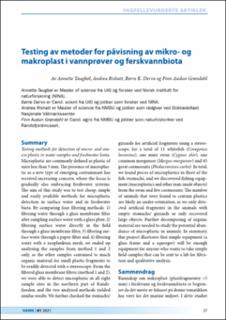Testing av metoder for påvisning av mikro- og makroplast i vannprøver og ferskvannbiota
Peer reviewed, Journal article
Published version

Åpne
Permanent lenke
https://hdl.handle.net/11250/2736752Utgivelsesdato
2021Metadata
Vis full innførselSamlinger
- Publikasjoner fra CRIStin - NINA [2364]
- Scientific publications [1392]
Originalversjon
Vann. 2021, (01-2021), 27-36.Sammendrag
Kunnskap om mikroplast (plastfragmenter <5 mm) i ferskvann og ferskvannsbiota er begrenset da det meste av fokuset på denne tematikken har vært for det marine miljøet. I dette studiet presenterer vi flere enkle og godt egnede metoder for innsamling og filtrering av vann for påvisning av mikroplast, samt metodiske utfordringer ved påvisning i magesekker fra fisk og fugl. Prøvetakningen av vann ble gjennomført i den nordlige delen av Randsfjorden fra åtte ulike stasjoner og fire ulike innsamlingsteknikker: 1) innsamling av vann med glassplate som senere ble filtrert gjennom glassfiberfilter, 2) direkte filtrering av overflatevann gjennom glassfiberfilter i felt, 3) filtrering av overflatevann gjennom et papirfilter og 4) filtrering av vann med planktonhov. De filtrerte prøvene ble gjennomgått med stereolupe og det ble satt et skår mellom 1-6 som kategoriserte hvor mange plastfragmenter filtrene inneholdt. Prøvene filtrert med papirfilter og planktonhov (metode 3 og 4) inneholdt for mye organisk materiale for at mikroplast kunne skilles ut effektivt og ble ikke analysert. Det ble funnet plastfragmenter på alle innsamlingsstasjonene og de to filtreringsmetodene (1 og 2) metodene var jevngode for påvisning av mikroplast. Et utvalg sik (Coregonus lavaretus) over 30 cm fikk dissekert ut og skåret opp magesekken, før innhold ble gjennomgått i stereolupe. Det ble funnet plastfragmenter i 3 av 11 analyserte fisk. Dette er trolig en underestimering, ettersom de 3 fiskene med positivt mikroplastfunn var de eneste som hadde tom magesekk, og dermed også høyere deteksjonsmulighet. Det ble videre foretatt et utvalg av innkommet fallvilt med opprinnelse fra Randsfjorden, der magesekk fra storskarv (Phalacrocorax carbo), laksand (Mergus merganser) og knoppsvane (Cygnus olor) ble analysert, der resultatene viser inntak av fiskeredskaper for de fleste undersøkte fuglene. Oppsummert viser dette studiet at enkle innsamlingsverktøy, som en glassplate og en nal, er alt man trenger for å samle inn en prøve vann til videre enkle analyser i laboratorium. Testing methods for detection of micro- and macro plastic in water samples and freshwater biota.
Microplastic are commonly defined as plastic of sizes less than 5 mm. The presence of microplastic
as a new type of emerging contaminant has received increasing concern, where the focus is
gradually also embracing freshwater systems. The aim of this study was to test cheap, simple
and easily available methods for microplastic detection in surface water and in freshwater
biota. By comparing four filtering methods:
1) filtering water through a glass membrane filter after sampling surface water with a glass plate,
2) filtering surface water directly in the field through a glass membrane filter,
3) filtering surface water through a paper-filter and,
4) filtering water with a zooplankton mesh, we ended up analyzing the samples from method 1 and 2
only, as the other samples contained to much organic material for small plastic-fragments to be readily detected with a stereoscope.
From thefiltered glass membrane filters (method 1 and 2), we were able to detect microplastic in all eight
sample sites in the northern part of Randsfjorden, and the two analyzed methods yielded similar results. We further checked the stomach’s/ gizzards for artificial fragments using a stereoscope, for a total of 11 whitefish (Coregonus lavaretus), one mute swan (Cygnus olor), one common merganser (Mergus merganser) and 45 great cormorants (Phalacrocorax carbo). In total, we found pieces of microplastics in three of the fish-stomachs, and we discovered fishing equipment (macroplastics and other man-made objects) from the swan and five cormorants. The number of animals that were found to contain plastics
are likely an under-estimation, as we only detected artificial fragments in the animals with empty stomachs/ gizzards or only recovered large objects. Further decomposing of organic material are needed to study the potential abundance of microplastic in animals.
In summary, this project illustrates that simple equipment (a glass frame and a squeegee) will be enough
equipment for anyone who wants to take simple field-samples that can be sent to a lab for filtration
and qualitative analysis.